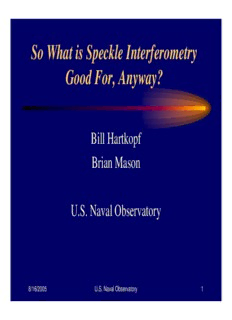
So What is Speckle Interferometry Good For, Anyway? PDF
Preview So What is Speckle Interferometry Good For, Anyway?
So What is Speckle Interferometry Good For, Anyway? Bill Hartkopf Brian Mason U.S. Naval Observatory 8/16/2005 U.S. Naval Observatory 1 So What is Speckle… An older (but not the oldest!), much simpler form of interferometry than you’ve been hearing about this week! : This talk will include • brief overview of speckle history and theory • types of science well-suited to speckle U.S. Naval Observatory a bit of background… • Earliest interferometry of binaries – Schwartzschild (1895) • Speckle technique proposed by Labeyrie (1969), first applied 1970 (binaries and stellar diameters) • 1970’s: photographic speckle programs by French, British, Soviets, Germans, U.S. (esp. McAlister et al.) • 1980’s: CCDs and other visible/IR detectors (cid:198) better sensitivity (cid:198) McCarthy, Leinert, Ghez, Karovska, etc. • 1990’s: Isobe, Scardia, Horch, USNO • 2000’s: Docobo; even within grasp of serious amateurs! U.S. Naval Observatory Handwaving speckle theory • Theoretically, resolution set by wavelength and aperture • Actually limited by atmosphere to size of turbulent cells (r ~10 – 20cm). Cells move due to wind, change size 0 • Telescope of aperture D sees (D/ r )2 cells 0 • Interference of light through cells with same tilt and group delay (cid:198) “speckle” pattern (moving cells (cid:198) “twinkling”) U.S. Naval Observatory Speckle pattern formation U.S. Naval Observatory More handwaving… • Isoplanicity = stars close enough (few arcseconds) for light from both to pass through same coherence cells • Short exposures needed to “freeze” atmosphere • Each isolated set of speckle pairs is diffraction-limited image - take multiple exposures and add images If I(α,β) = image intensity distribution O(α,β) = object intensity distribution |p(α,β)|2 = point spread function I(α,β) = O(α,β) * |p(α,β)|2 U.S. Naval Observatory Mpeg of Speckle data • STT 256 (discovered by Otto Struve, 1843) – sep = 1.008 arcsecs – V = 7.3 A – V = 7.6 B U.S. Naval Observatory More handwaving… Fourier transform of this intensity (cid:198) I(x,y) = o(x,y) . A[P(x,y)] and |I(x,y)|2 = |o(x,y)|2 . |A[P(x,y)]|2 where A is autocorrelation function Dividing FT of speckle images by FT of single star is essence of speckle interferometry. Simple alternative to full power spectrum analysis is vector autocorrelation U.S. Naval Observatory Reducing speckle data • Triple correlation, etc. – Computer- and time-intensive, ill-suited to surveys • Autocorrelation methods – straightforward, rapid, high data throughput – well-characterized errors, but – less sensitive to large ∆m – no full image reconstruction – only coarse differential photometry U.S. Naval Observatory Simple Autocorrelation speckle frame (cid:198) autocorrelation U.S. Naval Observatory
Description: